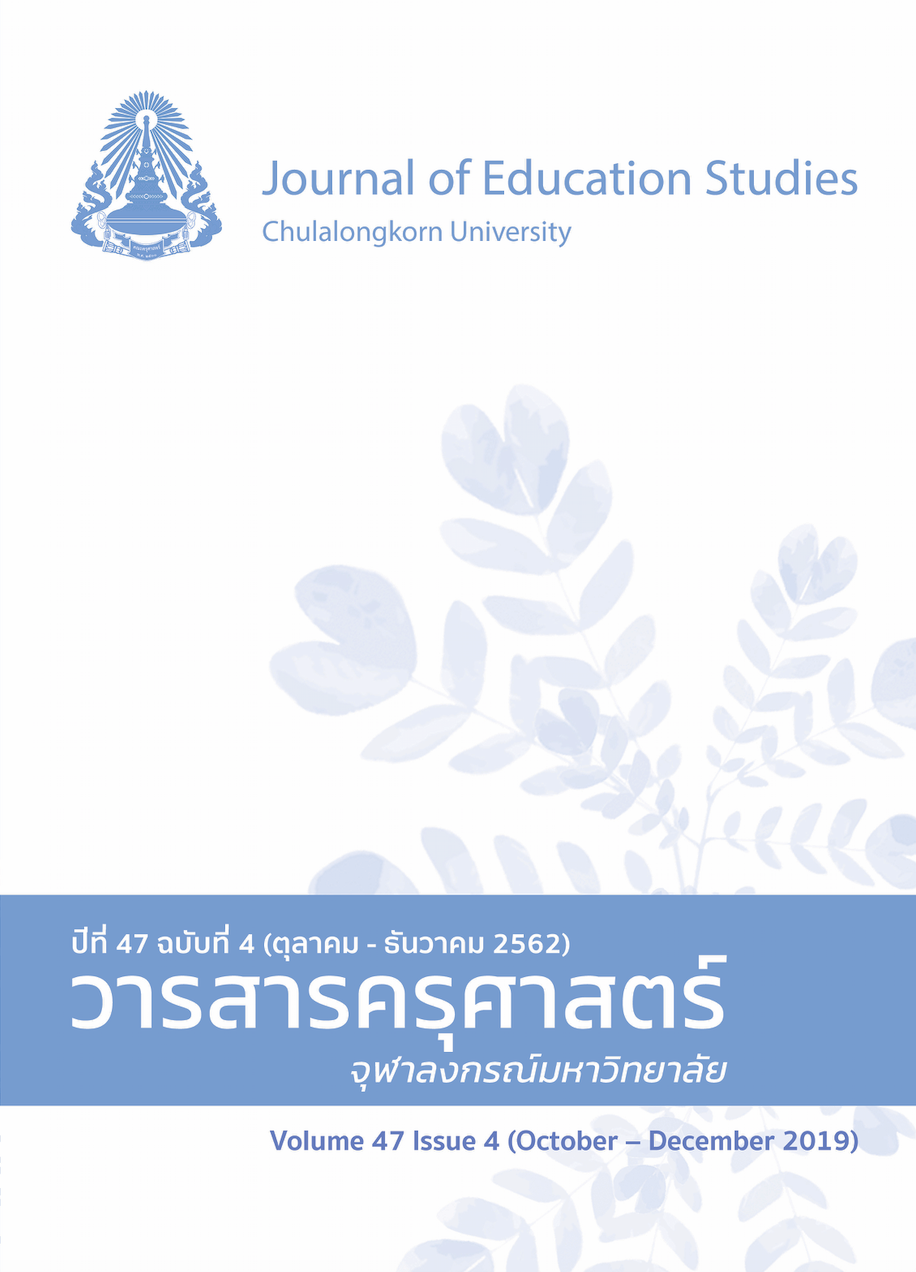The Social Determinant Factors and Policy Recommendations for an Efficient Management of State Educational Funding: A Case of Vocational Education in Thailand
Keywords:
EFFICIENCY MANAGEMENT, STATE EDUCATIONAL FUNDING, VOCATIONAL EDUCATIONAbstract
This article has two major objectives; to analyze the factors affecting the state's education funding for vocational education, and to provide policy recommendations for a better management. The authors applied the embedded design of mixed method. Four hundred samples from student-borrowers of vocational education were selected from a stratified three-stage cluster sampling. The rating scale questionnaires were employed and the multiple regression was applied for the data analysis. Qualitative research's grassroots technique was later applied through an in-depth interview of 10 student-borrowers of vocational education in Northeastern Thailand. The content analysis was used to assess the results.
Results of the analysis which reflected the empirical evidences of practical conducts in the 10 countries suggested that the efficiency of the student loan scheme were characterized by the following factors, (1) operation time period ranged from 21-25 years, (2) positive attitude towards loan repayment, (3) study expenses supports, (4) an absence of penalty enforced by the Student Loan Fund, (5) loan payment by direct debit, (6) payment via Krung Thai bank’s Tele Bank, (7) an absence of certification for household’s income, and (8) eligibility assessment by educational institution.
For a sustainable loan fund, this research recommends the following management policies: (1) improve recruitment criteria; (2) conduct training programmes for increasing repayment awareness; (3) prioritize lending for disadvantaged students; (4) enhance knowledge of the vocational institution counselors; (5) establish a strong learning network of the institution’s staff; and (6) implement efficient databases for collecting debt through tax repayment system; and (7) involving institutions provide summative evaluation.
References
Chairat, S. (2008). The study of the development models of loan collection for education loans fund (Unpublished Master’s Thesis). Naresuan University, Phitsanulok.
Chapman, B. (2006). Government managing risk: Income contingent loans for social and economic progress. New York: Routledge.
Chapman, B. (2014). Income contingent loans: Background. In B. Chapman, T. Higgins, & J. E. Stiglitz (Eds.), Income contingent loans; theory, practice and prospects (pp. 12-28). Hampshire: Palgrave Macmillan.
Chapman, B.(2016).Income-contingent loans in higher education financing internationally, there has been a student financing revolution towards income contingent loans. IZA World of Labor. 2016(227), 1-10.
Creswell, J. W. (2009). Research design qualitative, quantitative, and mixed methods approaches (3rd ed.). Thousand Oaks: Sage Publication Inc.
Engchanil, A. (August 20, 2018). Fairness of law and student loan fund policy. Retrieved from https://www.the101.world/student-loan-fund/
Jantori, P. (2012). Dual system study–the solution of the thai labor crisis, Journal of Business Administration, 35(135), 29-39.
Johnstone, D. B. (1986). Sharing the costs of higher education: Student financial assistance in the United Kingdom, the Federal Republic of Germany, France, Sweden, and the United States. New York: College Entrance Examination Board.
Johnstone, D. B.(2009). Conventional fixed-schedule versus income contingent repayment obligations: Is there a best loan scheme?. Journal Higher Education in Europe, 34(2009), 189-199.
Johnstone, D. B. (2010). The significance of globalization to American higher education. In D. B. Johnstone, M. B. d’Ambrosio, & P. J. Yakoboski (Eds.), Higher Education in a Global Society (pp. 14-24). Cheltenham: Edward Elgar Publishing Limited.
Kypuros, C. A. (2009). Factor affecting student loan default rate: Nevada system of higher education. Retrived from https://eric.ed.gov/?id=ED531161
Lounkaew, K. (2015, 2 October). Debt settlement with the corners is not looking. Bangkokbiznews. Retrieved from https://www.bangkokbiznews.com/blog/detail/635734
Lueangwongngam, S. (2015). A management strategy of tracking system for student loans fund. Journal of Education, 26(3), 217-228.
Migali, G. (2012). Funding higher education and wage uncertainty: Income contingent loan versus mortgage loan. Economics of Education Review, 31(2012), 871–889.
Office of the Education Council, Ministry of Education. (2014). A report of analysis of the results of the Thailand student loan for the accessibility and quality of education: A case study of Khon Kaen. Bangkok: Phrik Wan Krap Fik.
Patmasiriwat, D. (2009). Educational finance: Return to higher education and educational loan programs. Economics and Public Policy Journal, 5(5), 7-33.
Phuangprayong, K. (2011).The evaluation of student loan fund: A case study of vocational education institutions in Samutsongkhram Province (Unpublished Master’s Thesis). National Institute of Development Administration (NIDA), Bangkok.
Sabatier, P. (1986). Top-down and bottom-up approaches to implementation research: A critical analysis and suggested synthesis. Journal of Public Policy, 6(1), 21-48. Retrieved from http://www.jstor.org/stable/3998354
Talasophon, S. (2011). An analysis and evaluation of Thai student loan scheme implementation and deferred debts. NIDA Development Journal, 11(4), 153-175.
Tantipisanu, C., & Jesdapipat, S. (2013). Enhancing the financial management capacity of the student loans fund. Quality of Life and Law Journal, 9(3), 54-70.
Tirasriwat, A. (2016). Student loan defaults in Thailand: Problem and guideline for solutions, Journal of Business Administration, 5(1), 121-144.
The United Nations Educational, Scientific and Cultural Organization [UNESCO]. (2017a). Ensuring adequate, efficient and equitable finance in schools in the Asia-Pacific Region. Bangkok: UNESCO Bangkok Office.
The United Nations Educational, Scientific and Cultural Organization [UNESCO]. (2017b). Education for sustainable development goals: Learning objective. Paris: the United Nations Educational, Scientific and Cultural Organization. Retrieved from http://unesdoc.unesco.org/images/0024/002474/247444e.pdf
Woodhall, M. (1983). Student loans as a financing hgher education lesson from international experience. Washington, D.C.: The World Bank.
Woodhall, M. (1992). Student loans in developing countries: Feasibility, experience, and prospects for reform. Higher Education, 23(4), 347-356. Retrieved from http://www.jstor.org/stable/3447351
Woodhall, M. (2007). Funding higher education; contribution of economic thinking to debate and policy development. Washington D.C.: World Bank.
Yamyindee, P., Amdonkroy, S., & Jaicharad, N. (2013). A study on the causes at risk of vocational student dropouts of bungphra phitsanulok commercial college, office of vocational education commission. Journal of Graduate Studies in Northern Rajabhat Universities, 3(5), 1-14.
Ziderman, A. (2004). Policy options for student loan schemes: Lessons from five Asian case studies. Bangkok: UNESCO.




